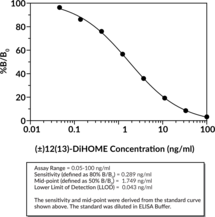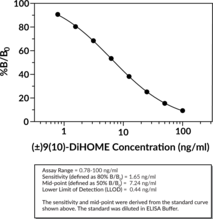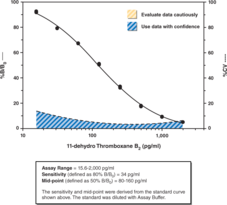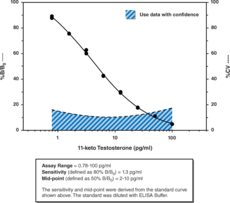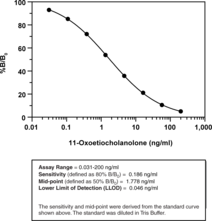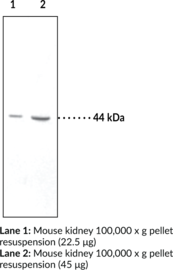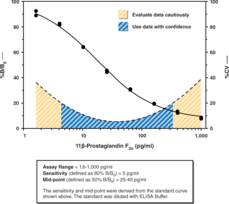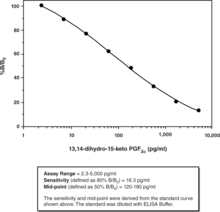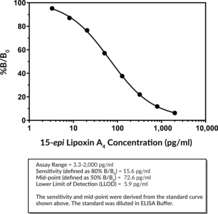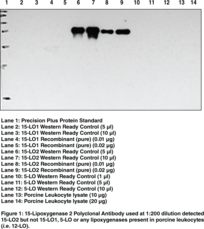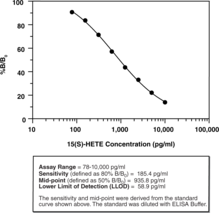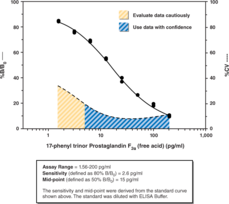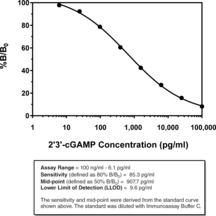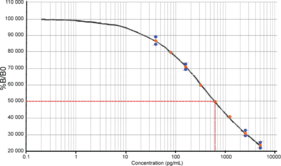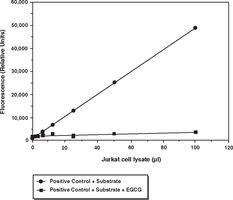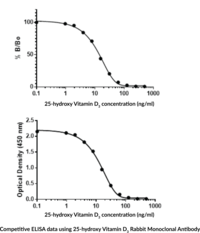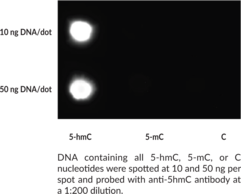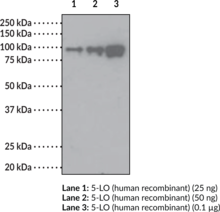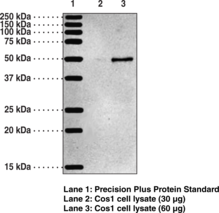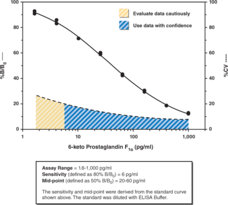ELISA Kits
Showing 1–150 of 3623 results
-
Cayman’s (±)12(13)-DiHOME ELISA Kit is a competitive assay that can be used for quantification of 12(13)-DiHOME in plasma, serum, and bronchoalveolar lavage fluid (BALF). The assay has a range of 0.05-100 ng/ml and a sensitivity (80% B/B0) of approximately 0.3 ng/ml.
Brand:CaymanSKU:501720 - 96 solid wellsAvailable on backorder
Cayman’s (±)12(13)-DiHOME ELISA Kit is a competitive assay that can be used for quantification of 12(13)-DiHOME in plasma, serum, and bronchoalveolar lavage fluid (BALF). The assay has a range of 0.05-100 ng/ml and a sensitivity (80% B/B0) of approximately 0.3 ng/ml.
Brand:CaymanSKU:501720 - 96 strip wellsAvailable on backorder
Cayman’s (±)9(10)-DiHOME ELISA Kit is a competitive assay that can be used for the quantification of 9(10)-DiHOME in plasma, serum, and bronchoalveolar lavage fluid (BALF). This assay has a range of 0.78-100 ng/ml and a sensitivity (80% B/B0) of approximately 1.6 ng/ml.
Brand:CaymanSKU:501710 - 96 solid wellsAvailable on backorder
Cayman’s (±)9(10)-DiHOME ELISA Kit is a competitive assay that can be used for the quantification of 9(10)-DiHOME in plasma, serum, and bronchoalveolar lavage fluid (BALF). This assay has a range of 0.78-100 ng/ml and a sensitivity (80% B/B0) of approximately 1.6 ng/ml.
Brand:CaymanSKU:501710 - 96 strip wellsAvailable on backorder
Thromboxane A2 (TXA2), produced from arachidonic acid, causes irreversible platelet aggregation, vascular, and bronchial smooth muscle contraction. TXA2 is rapidly hydrolyzed non-enzymatically to form TXB2. However, most of the TXB2 measured in the plasma or urine of healthy individuals is due to ex vivo platelet activation or intra-renal production, and normal concentrations of circulating TXB2 are extremely low (1-2 pg/ml) and highly transient (t½ = 5-7 minutes). 11-dehydro TXB2 is a metabolite of TXB2 (not formed by platelets or the kidney) with a circulating half-life (t½) of 45 minutes. Its measurement in plasma or urine will give a time-integrated indication of TXA2 production and is recommended to estimate TXA2 levels to circumvent measurement complications associated with TXB2. Cayman’s 11-dehydro TXB2 ELISA Kit is a competitive assay that can be used for quantification of 11-dehydro TXB2 in urine and other sample matrices. Normal plasma levels of 11-dehydro TXB2 (1-2 pg/ml) are below the detection limit of this assay (16 pg/ml), so plasma samples must be purified and concentrated prior to analysis. Urine samples should be diluted appropriately before assaying. There is evidence suggesting that 11-dehydro TXB2 can be formed non-enzymatically following platelet activation, so it is important to process plasma samples quickly to prevent artifactual formation of 11-dehydro TXB2. The assay has a range from 15.6-2,000 pg/ml and a sensitivity (80% B/B0) of approximately 34 pg/ml.
Brand:CaymanSKU:519510 - 480 solid wellsAvailable on backorder
Thromboxane A2 (TXA2), produced from arachidonic acid, causes irreversible platelet aggregation, vascular, and bronchial smooth muscle contraction. TXA2 is rapidly hydrolyzed non-enzymatically to form TXB2. However, most of the TXB2 measured in the plasma or urine of healthy individuals is due to ex vivo platelet activation or intra-renal production, and normal concentrations of circulating TXB2 are extremely low (1-2 pg/ml) and highly transient (t½ = 5-7 minutes). 11-dehydro TXB2 is a metabolite of TXB2 (not formed by platelets or the kidney) with a circulating half-life (t½) of 45 minutes. Its measurement in plasma or urine will give a time-integrated indication of TXA2 production and is recommended to estimate TXA2 levels to circumvent measurement complications associated with TXB2. Cayman’s 11-dehydro TXB2 ELISA Kit is a competitive assay that can be used for quantification of 11-dehydro TXB2 in urine and other sample matrices. Normal plasma levels of 11-dehydro TXB2 (1-2 pg/ml) are below the detection limit of this assay (16 pg/ml), so plasma samples must be purified and concentrated prior to analysis. Urine samples should be diluted appropriately before assaying. There is evidence suggesting that 11-dehydro TXB2 can be formed non-enzymatically following platelet activation, so it is important to process plasma samples quickly to prevent artifactual formation of 11-dehydro TXB2. The assay has a range from 15.6-2,000 pg/ml and a sensitivity (80% B/B0) of approximately 34 pg/ml.
Brand:CaymanSKU:519510 - 480 strip wellsAvailable on backorder
Thromboxane A2 (TXA2), produced from arachidonic acid, causes irreversible platelet aggregation, vascular, and bronchial smooth muscle contraction. TXA2 is rapidly hydrolyzed non-enzymatically to form TXB2. However, most of the TXB2 measured in the plasma or urine of healthy individuals is due to ex vivo platelet activation or intra-renal production, and normal concentrations of circulating TXB2 are extremely low (1-2 pg/ml) and highly transient (t½ = 5-7 minutes). 11-dehydro TXB2 is a metabolite of TXB2 (not formed by platelets or the kidney) with a circulating half-life (t½) of 45 minutes. Its measurement in plasma or urine will give a time-integrated indication of TXA2 production and is recommended to estimate TXA2 levels to circumvent measurement complications associated with TXB2. Cayman’s 11-dehydro TXB2 ELISA Kit is a competitive assay that can be used for quantification of 11-dehydro TXB2 in urine and other sample matrices. Normal plasma levels of 11-dehydro TXB2 (1-2 pg/ml) are below the detection limit of this assay (16 pg/ml), so plasma samples must be purified and concentrated prior to analysis. Urine samples should be diluted appropriately before assaying. There is evidence suggesting that 11-dehydro TXB2 can be formed non-enzymatically following platelet activation, so it is important to process plasma samples quickly to prevent artifactual formation of 11-dehydro TXB2. The assay has a range from 15.6-2,000 pg/ml and a sensitivity (80% B/B0) of approximately 34 pg/ml.
Brand:CaymanSKU:519510 - 96 solid wellsAvailable on backorder
Thromboxane A2 (TXA2), produced from arachidonic acid, causes irreversible platelet aggregation, vascular, and bronchial smooth muscle contraction. TXA2 is rapidly hydrolyzed non-enzymatically to form TXB2. However, most of the TXB2 measured in the plasma or urine of healthy individuals is due to ex vivo platelet activation or intra-renal production, and normal concentrations of circulating TXB2 are extremely low (1-2 pg/ml) and highly transient (t½ = 5-7 minutes). 11-dehydro TXB2 is a metabolite of TXB2 (not formed by platelets or the kidney) with a circulating half-life (t½) of 45 minutes. Its measurement in plasma or urine will give a time-integrated indication of TXA2 production and is recommended to estimate TXA2 levels to circumvent measurement complications associated with TXB2. Cayman’s 11-dehydro TXB2 ELISA Kit is a competitive assay that can be used for quantification of 11-dehydro TXB2 in urine and other sample matrices. Normal plasma levels of 11-dehydro TXB2 (1-2 pg/ml) are below the detection limit of this assay (16 pg/ml), so plasma samples must be purified and concentrated prior to analysis. Urine samples should be diluted appropriately before assaying. There is evidence suggesting that 11-dehydro TXB2 can be formed non-enzymatically following platelet activation, so it is important to process plasma samples quickly to prevent artifactual formation of 11-dehydro TXB2. The assay has a range from 15.6-2,000 pg/ml and a sensitivity (80% B/B0) of approximately 34 pg/ml.
Brand:CaymanSKU:519510 - 96 strip wellsAvailable on backorder
Brand:CaymanSKU:419512 - 100 dtnAvailable on backorder
Brand:CaymanSKU:419512 - 500 dtnAvailable on backorder
11-dehydro Thromboxane B2 Monoclonal Assay Buffer Concentrate (10X) has been formulated and tested to work with Cayman’s ELISA Kits. Detailed instructions for its use are contained in the respective Cayman ELISA Kit booklet.
Brand:CaymanSKU:419517 - 10 mlAvailable on backorder
Brand:CaymanSKU:419514 - 100 ngAvailable on backorder
Brand:CaymanSKU:482752 - 100 dtnAvailable on backorder
Brand:CaymanSKU:482752 - 500 dtnAvailable on backorder
While testosterone is the primary androgenic male steroid found in mammals, 11-keto testosterone (11-KT) is a second key androgenic steroid found in fish. It occurs in males together with testosterone in amounts which vary from less than 1 ng/ml to as much as 50-100 ng/ml, depending on the species and the stage of the reproductive cycle. In the sea bass, testosterone concentrations are generally higher than 11-KT, with peak levels found after the spawning season. 11-KT, on the other hand, remains at levels less than 1 ng/ml but rises abruptly to 4-6 ng/ml during spermiation at the height of the spawning season.{8544} 11-KT also shows individual variations in Arctic char, with dominant males having significantly higher 11-KT levels.{8325}
Brand:CaymanSKU:582751 - 480 solid wellsAvailable on backorder
While testosterone is the primary androgenic male steroid found in mammals, 11-keto testosterone (11-KT) is a second key androgenic steroid found in fish. It occurs in males together with testosterone in amounts which vary from less than 1 ng/ml to as much as 50-100 ng/ml, depending on the species and the stage of the reproductive cycle. In the sea bass, testosterone concentrations are generally higher than 11-KT, with peak levels found after the spawning season. 11-KT, on the other hand, remains at levels less than 1 ng/ml but rises abruptly to 4-6 ng/ml during spermiation at the height of the spawning season.{8544} 11-KT also shows individual variations in Arctic char, with dominant males having significantly higher 11-KT levels.{8325}
Brand:CaymanSKU:582751 - 480 strip wellsAvailable on backorder
While testosterone is the primary androgenic male steroid found in mammals, 11-keto testosterone (11-KT) is a second key androgenic steroid found in fish. It occurs in males together with testosterone in amounts which vary from less than 1 ng/ml to as much as 50-100 ng/ml, depending on the species and the stage of the reproductive cycle. In the sea bass, testosterone concentrations are generally higher than 11-KT, with peak levels found after the spawning season. 11-KT, on the other hand, remains at levels less than 1 ng/ml but rises abruptly to 4-6 ng/ml during spermiation at the height of the spawning season.{8544} 11-KT also shows individual variations in Arctic char, with dominant males having significantly higher 11-KT levels.{8325}
Brand:CaymanSKU:582751 - 96 solid wellsAvailable on backorder
While testosterone is the primary androgenic male steroid found in mammals, 11-keto testosterone (11-KT) is a second key androgenic steroid found in fish. It occurs in males together with testosterone in amounts which vary from less than 1 ng/ml to as much as 50-100 ng/ml, depending on the species and the stage of the reproductive cycle. In the sea bass, testosterone concentrations are generally higher than 11-KT, with peak levels found after the spawning season. 11-KT, on the other hand, remains at levels less than 1 ng/ml but rises abruptly to 4-6 ng/ml during spermiation at the height of the spawning season.{8544} 11-KT also shows individual variations in Arctic char, with dominant males having significantly higher 11-KT levels.{8325}
Brand:CaymanSKU:582751 - 96 strip wellsAvailable on backorder
Brand:CaymanSKU:482754 - 1 eaAvailable on backorder
11-Oxoetiocholanolone is a metabolite of cortisol that is found in the feces of ungulates and other animals. Stress-induced glucocorticoids (cortisol, corticosterone) traditionally have been measured through blood sampling, but the collection process is known to cause stress in animals, interfering with experimental results.{19086} Fecal sample analysis provides more accurate detection of stress hormones, and it can be used to measure stress in both laboratory and free-ranging animals.{19086} 11-Oxoetiocholanolone is also found in human urine. Increased levels of urinary 11-oxoetiocholanolone have been observed in the latter part of pregnancy and in patients with uterine leiomyomas.{35076,35077} A study of postmenopausal women determined that 11-oxoetiocholanolone was indicative of stress-induced urinary incontinence.{35075}
Brand:CaymanSKU:501420 - 96 solid wellsAvailable on backorder
11-Oxoetiocholanolone is a metabolite of cortisol that is found in the feces of ungulates and other animals. Stress-induced glucocorticoids (cortisol, corticosterone) traditionally have been measured through blood sampling, but the collection process is known to cause stress in animals, interfering with experimental results.{19086} Fecal sample analysis provides more accurate detection of stress hormones, and it can be used to measure stress in both laboratory and free-ranging animals.{19086} 11-Oxoetiocholanolone is also found in human urine. Increased levels of urinary 11-oxoetiocholanolone have been observed in the latter part of pregnancy and in patients with uterine leiomyomas.{35076,35077} A study of postmenopausal women determined that 11-oxoetiocholanolone was indicative of stress-induced urinary incontinence.{35075}
Brand:CaymanSKU:501420 - 96 strip wellsAvailable on backorder
11β-Hydroxysteroid dehydrogenase (Type 1) (11β-HSD1) catalyzes the conversion of inactive cortisone to active cortisol in adipose tissue. mRNA and protein for this enzyme have been detected in a wide range of tissues including liver, kidney, testis, lung, heart, and colon.{12000} The enzyme’s expression is developmentally regulated, suggesting its importance in regulation of glucocorticoid action during embryonic development.{11999} Over-expression of 11β-HSD1 results in visceral obesity and metabolic syndrome including insulin-resistant diabetes, hyperlipidemia, and hyperphagia.{9545} Cayman’s 11β-HSD1 Polyclonal Antibody detects a 32 kDa protein in human, mouse, and rat liver samples by western blot analysis. The antibody can be used on paraffin-embedded tissue sections to detect 11β-HSD1 expression.
Brand:CaymanSKU:10004303 - 1 eaAvailable on backorder
11β-HSD2 plays a critical role in normal physiology in the corticosteroid regulation of sodium homeostasis and the pathophysiology of hypertension by converting active cortisol to inactive cortisone. Mutation in the gene encoding 11β-HSD2 results in cortisol induction of hypertension and hypokalemia, a syndrome of apparent mineralocorticoid excess.{11854} 11β-HSD2 mRNA and protein are expressed in placenta and mineralocorticoid target tissues, particularly the kidney.{12000} In mouse, expression of this enzyme is tissue-specific and developmentally regulated, indicating the importance of the enzyme in controlling glucocorticoid-mediated maturation.{11999} Cayman’s 11β-HSD2 Polyclonal Antibody can be used for Western blotting and immunohistochemical analysis of 11β-HSD2 from samples of human, rat, and mouse. The antibody detects a band at 44 kDa in tissues such as kidney and cell lines including Caco-2 cells and HT-29 cells.
Brand:CaymanSKU:10004549 - 1 eaAvailable on backorder
Brand:CaymanSKU:416522 - 100 dtnAvailable on backorder
Brand:CaymanSKU:416522 - 500 dtnAvailable on backorder
Prostaglandin D2 (PGD2) is the major eicosanoid released from stimulated mast cells. PGD2 is an unstable compound which is rapidly metabolized and eliminated from the circulation. This makes quantitation of PGD2 an unreliable indicator of its in vivo production. 11β-PGF2α is the primary plasma metabolite of PGD2 in vivo, the levels of which can increase from 6 pg/ml in a normal healthy volunteer to 490 ng/ml in patients with systemic mastocytosis.{493} The normal human urinary excretion of 11β-PGF2α is about 11 ng/mmol creatinine (~400 ng/24 hr), which is increased nearly 3-fold upon allergen-induced bronchoconstriction in asthmatics.{7577,3519} Unlike most prostaglandin metabolites, 11β-PGF2α retains potent biological activity. 11-β-PGF2α is equipotent to PGF2α in inducing human bronchial smooth muscle contractions and inhibition of adipose differentiation.{1756,2053} 11β-PGF2α was also shown to inhibit ADP or thrombin-induced human platelet aggregation at concentrations of 0.14 to 2.8 µM. {494} The Cayman 11β-PGF2α Assay is a competitive assay that provides accurate measurements of 11β-PGF2α within the range of 1.6-1,000 pg/ml. Inter and intra-assay CV’s of less than 15% can be achieved at most concentrations. This assay allows sensitive detection of 11β-PGF2α in the most common sample matrix, which is urine. For plasma and other complex sample matrices, we recommend purification of the sample prior to analysis; a purification protocol is included in the kit booklet. Measurements of 11β-PGF2α in urine using our ELISA gives values in the same range, but slightly higher than those obtained by GC-MS. This appears to be due to measurement of 11β-PGF2α plus the 2,3-dinor metabolite of 11β-PGF2α.{7577}
Brand:CaymanSKU:516521 - 480 solid wellsAvailable on backorder
Prostaglandin D2 (PGD2) is the major eicosanoid released from stimulated mast cells. PGD2 is an unstable compound which is rapidly metabolized and eliminated from the circulation. This makes quantitation of PGD2 an unreliable indicator of its in vivo production. 11β-PGF2α is the primary plasma metabolite of PGD2 in vivo, the levels of which can increase from 6 pg/ml in a normal healthy volunteer to 490 ng/ml in patients with systemic mastocytosis.{493} The normal human urinary excretion of 11β-PGF2α is about 11 ng/mmol creatinine (~400 ng/24 hr), which is increased nearly 3-fold upon allergen-induced bronchoconstriction in asthmatics.{7577,3519} Unlike most prostaglandin metabolites, 11β-PGF2α retains potent biological activity. 11-β-PGF2α is equipotent to PGF2α in inducing human bronchial smooth muscle contractions and inhibition of adipose differentiation.{1756,2053} 11β-PGF2α was also shown to inhibit ADP or thrombin-induced human platelet aggregation at concentrations of 0.14 to 2.8 µM. {494} The Cayman 11β-PGF2α Assay is a competitive assay that provides accurate measurements of 11β-PGF2α within the range of 1.6-1,000 pg/ml. Inter and intra-assay CV’s of less than 15% can be achieved at most concentrations. This assay allows sensitive detection of 11β-PGF2α in the most common sample matrix, which is urine. For plasma and other complex sample matrices, we recommend purification of the sample prior to analysis; a purification protocol is included in the kit booklet. Measurements of 11β-PGF2α in urine using our ELISA gives values in the same range, but slightly higher than those obtained by GC-MS. This appears to be due to measurement of 11β-PGF2α plus the 2,3-dinor metabolite of 11β-PGF2α.{7577}
Brand:CaymanSKU:516521 - 480 strip wellsAvailable on backorder
Prostaglandin D2 (PGD2) is the major eicosanoid released from stimulated mast cells. PGD2 is an unstable compound which is rapidly metabolized and eliminated from the circulation. This makes quantitation of PGD2 an unreliable indicator of its in vivo production. 11β-PGF2α is the primary plasma metabolite of PGD2 in vivo, the levels of which can increase from 6 pg/ml in a normal healthy volunteer to 490 ng/ml in patients with systemic mastocytosis.{493} The normal human urinary excretion of 11β-PGF2α is about 11 ng/mmol creatinine (~400 ng/24 hr), which is increased nearly 3-fold upon allergen-induced bronchoconstriction in asthmatics.{7577,3519} Unlike most prostaglandin metabolites, 11β-PGF2α retains potent biological activity. 11-β-PGF2α is equipotent to PGF2α in inducing human bronchial smooth muscle contractions and inhibition of adipose differentiation.{1756,2053} 11β-PGF2α was also shown to inhibit ADP or thrombin-induced human platelet aggregation at concentrations of 0.14 to 2.8 µM. {494} The Cayman 11β-PGF2α Assay is a competitive assay that provides accurate measurements of 11β-PGF2α within the range of 1.6-1,000 pg/ml. Inter and intra-assay CV’s of less than 15% can be achieved at most concentrations. This assay allows sensitive detection of 11β-PGF2α in the most common sample matrix, which is urine. For plasma and other complex sample matrices, we recommend purification of the sample prior to analysis; a purification protocol is included in the kit booklet. Measurements of 11β-PGF2α in urine using our ELISA gives values in the same range, but slightly higher than those obtained by GC-MS. This appears to be due to measurement of 11β-PGF2α plus the 2,3-dinor metabolite of 11β-PGF2α.{7577}
Brand:CaymanSKU:516521 - 96 solid wellsAvailable on backorder
Prostaglandin D2 (PGD2) is the major eicosanoid released from stimulated mast cells. PGD2 is an unstable compound which is rapidly metabolized and eliminated from the circulation. This makes quantitation of PGD2 an unreliable indicator of its in vivo production. 11β-PGF2α is the primary plasma metabolite of PGD2 in vivo, the levels of which can increase from 6 pg/ml in a normal healthy volunteer to 490 ng/ml in patients with systemic mastocytosis.{493} The normal human urinary excretion of 11β-PGF2α is about 11 ng/mmol creatinine (~400 ng/24 hr), which is increased nearly 3-fold upon allergen-induced bronchoconstriction in asthmatics.{7577,3519} Unlike most prostaglandin metabolites, 11β-PGF2α retains potent biological activity. 11-β-PGF2α is equipotent to PGF2α in inducing human bronchial smooth muscle contractions and inhibition of adipose differentiation.{1756,2053} 11β-PGF2α was also shown to inhibit ADP or thrombin-induced human platelet aggregation at concentrations of 0.14 to 2.8 µM. {494} The Cayman 11β-PGF2α Assay is a competitive assay that provides accurate measurements of 11β-PGF2α within the range of 1.6-1,000 pg/ml. Inter and intra-assay CV’s of less than 15% can be achieved at most concentrations. This assay allows sensitive detection of 11β-PGF2α in the most common sample matrix, which is urine. For plasma and other complex sample matrices, we recommend purification of the sample prior to analysis; a purification protocol is included in the kit booklet. Measurements of 11β-PGF2α in urine using our ELISA gives values in the same range, but slightly higher than those obtained by GC-MS. This appears to be due to measurement of 11β-PGF2α plus the 2,3-dinor metabolite of 11β-PGF2α.{7577}
Brand:CaymanSKU:516521 - 96 strip wellsAvailable on backorder
Brand:CaymanSKU:416524 - 1 eaAvailable on backorder
Brand:CaymanSKU:416672 - 100 dtnAvailable on backorder
Brand:CaymanSKU:416672 - 500 dtnAvailable on backorder
Prostaglandin F2α (PGF2α) is one of the five primary prostaglandins derived enzymatically directly from the endoperoxide PGH2. PGF2α was initially discovered in seminal fluid, and to date the majority of the functional roles ascribed to it relate to fertility, pregnancy, and parturition. PGF2α is a potent luteolytic agent and is used to induce ovulation in domestic livestock. It is also a potent uterine stimulant, and is part of the cascade of myometrial stimulants which induce and sustain labor. PGF2α is rapidly metabolized to 13,14-dihydro-15-keto PGF2α in vivo, by the enzymes 15-hydroxy prostaglandin dehydrogenase and Δ13-reductucase.{310,1157,5442,387} Measurement of 13,14-dihydro-15-keto PGF2α in plasma can be used as a marker of the in vivo production of PGF2α.{878,1463} The Cayman Chemical 13,14-dihydro-15-keto PGF2α Enzyme Immunoassay is a competitive assay that provides measurements of 13,14-dihydro-15-keto PGF2α within the range of 2.3-5,000 pg/ml, typically with a detection limit (80% B/B0) of approximately 15 pg/ml. Although the tracer and antiserum for this assay have been sold separately for many years, the reagents are now combined with an accurate standard and packaged together in a convenient assay kit. The assay has been validated for the measurement of 13,14-dihydro-15-keto PGF2α in plasma, a common matrix for measurement of this PGF2α metabolite.{878}
Brand:CaymanSKU:516671 - 480 solid wellsAvailable on backorder
Prostaglandin F2α (PGF2α) is one of the five primary prostaglandins derived enzymatically directly from the endoperoxide PGH2. PGF2α was initially discovered in seminal fluid, and to date the majority of the functional roles ascribed to it relate to fertility, pregnancy, and parturition. PGF2α is a potent luteolytic agent and is used to induce ovulation in domestic livestock. It is also a potent uterine stimulant, and is part of the cascade of myometrial stimulants which induce and sustain labor. PGF2α is rapidly metabolized to 13,14-dihydro-15-keto PGF2α in vivo, by the enzymes 15-hydroxy prostaglandin dehydrogenase and Δ13-reductucase.{310,1157,5442,387} Measurement of 13,14-dihydro-15-keto PGF2α in plasma can be used as a marker of the in vivo production of PGF2α.{878,1463} The Cayman Chemical 13,14-dihydro-15-keto PGF2α Enzyme Immunoassay is a competitive assay that provides measurements of 13,14-dihydro-15-keto PGF2α within the range of 2.3-5,000 pg/ml, typically with a detection limit (80% B/B0) of approximately 15 pg/ml. Although the tracer and antiserum for this assay have been sold separately for many years, the reagents are now combined with an accurate standard and packaged together in a convenient assay kit. The assay has been validated for the measurement of 13,14-dihydro-15-keto PGF2α in plasma, a common matrix for measurement of this PGF2α metabolite.{878}
Brand:CaymanSKU:516671 - 480 strip wellsAvailable on backorder
Prostaglandin F2α (PGF2α) is one of the five primary prostaglandins derived enzymatically directly from the endoperoxide PGH2. PGF2α was initially discovered in seminal fluid, and to date the majority of the functional roles ascribed to it relate to fertility, pregnancy, and parturition. PGF2α is a potent luteolytic agent and is used to induce ovulation in domestic livestock. It is also a potent uterine stimulant, and is part of the cascade of myometrial stimulants which induce and sustain labor. PGF2α is rapidly metabolized to 13,14-dihydro-15-keto PGF2α in vivo, by the enzymes 15-hydroxy prostaglandin dehydrogenase and Δ13-reductucase.{310,1157,5442,387} Measurement of 13,14-dihydro-15-keto PGF2α in plasma can be used as a marker of the in vivo production of PGF2α.{878,1463} The Cayman Chemical 13,14-dihydro-15-keto PGF2α Enzyme Immunoassay is a competitive assay that provides measurements of 13,14-dihydro-15-keto PGF2α within the range of 2.3-5,000 pg/ml, typically with a detection limit (80% B/B0) of approximately 15 pg/ml. Although the tracer and antiserum for this assay have been sold separately for many years, the reagents are now combined with an accurate standard and packaged together in a convenient assay kit. The assay has been validated for the measurement of 13,14-dihydro-15-keto PGF2α in plasma, a common matrix for measurement of this PGF2α metabolite.{878}
Brand:CaymanSKU:516671 - 96 solid wellsAvailable on backorder
Prostaglandin F2α (PGF2α) is one of the five primary prostaglandins derived enzymatically directly from the endoperoxide PGH2. PGF2α was initially discovered in seminal fluid, and to date the majority of the functional roles ascribed to it relate to fertility, pregnancy, and parturition. PGF2α is a potent luteolytic agent and is used to induce ovulation in domestic livestock. It is also a potent uterine stimulant, and is part of the cascade of myometrial stimulants which induce and sustain labor. PGF2α is rapidly metabolized to 13,14-dihydro-15-keto PGF2α in vivo, by the enzymes 15-hydroxy prostaglandin dehydrogenase and Δ13-reductucase.{310,1157,5442,387} Measurement of 13,14-dihydro-15-keto PGF2α in plasma can be used as a marker of the in vivo production of PGF2α.{878,1463} The Cayman Chemical 13,14-dihydro-15-keto PGF2α Enzyme Immunoassay is a competitive assay that provides measurements of 13,14-dihydro-15-keto PGF2α within the range of 2.3-5,000 pg/ml, typically with a detection limit (80% B/B0) of approximately 15 pg/ml. Although the tracer and antiserum for this assay have been sold separately for many years, the reagents are now combined with an accurate standard and packaged together in a convenient assay kit. The assay has been validated for the measurement of 13,14-dihydro-15-keto PGF2α in plasma, a common matrix for measurement of this PGF2α metabolite.{878}
Brand:CaymanSKU:516671 - 96 strip wellsAvailable on backorder
Brand:CaymanSKU:416674 - 1 eaAvailable on backorder
Cayman’s 15-epi Lipoxin A4 (15-epi LXA4) ELISA Kit is a competitive assay that can be used for quantification of 15-epi LXA4 in plasma, serum, and urine. The assay has a range of 3.3-2,000 pg/ml and a sensitivity (80% B/B0) of approximately 16 pg/ml.
Brand:CaymanSKU:590415 - 96 solid wellAvailable on backorder
Cayman’s 15-epi Lipoxin A4 (15-epi LXA4) ELISA Kit is a competitive assay that can be used for quantification of 15-epi LXA4 in plasma, serum, and urine. The assay has a range of 3.3-2,000 pg/ml and a sensitivity (80% B/B0) of approximately 16 pg/ml.
Brand:CaymanSKU:590415 - 96 strip wellAvailable on backorder
NAD+-dependent 15-hydroxy PGDH catalyzes the oxidation of prostaglandins to 15-keto metabolites, which have greatly reduced biological activity.{340} Human NAD+-dependent 15-hydroxy PGDH is a 266 amino acid protein with a molecular weight of 29 kDa and is expressed in multiple tissues including lung, placenta, and kidney.{387} The enzyme belongs to a large family of short-chain alcohol dehydrogenases, which exhibit amino acid identity ranging from 15-30%.{8277,5201} An NADP+-dependent 15-hydroxy PGDH, which is also part of this enzyme family, exhibits only 20% amino acid identity to the NAD+-dependent enzyme.{8401} The peptide used as the antigen for preparation of the 15-hydroxy PGDH antibody is highly conserved across several species (see above), but has only minor homology to other proteins within the short-chain alcohol dehydrogenase family of enzymes (only the alanine and glycine at the N-terminus of the sequence appear to be conserved).{8277} Cayman’s 15-hydroxy PGDH Polyclonal Antibody can be used for Western blot applications. The antibody recognizes 15-hydroxy PGDH at 29 kDa from human, baboon, and mouse samples.
Brand:CaymanSKU:160615 - 1 eaAvailable on backorder
Two types of 15-LO have been discovered and characterized, both of which metabolize arachidonic acid (AA) to produce 15(S)-hydroxyeicosatetraenoic acid (15(S)-HETE). 15-LO-1 oxygenates AA at both C15 and C12,{11792} whereas 15-LO-2 exclusively oxygenates C15 of AA.{4675} Human 15-LO-2 has a molecular mass of approximately 76 kDa and exhibits approximately 40% identity to the reticulocyte 15-LO-1.{4675,11789} Expression of 15-LO-2 appears to be restricted to prostate, lung, skin, and cornea and may play a role in the normal development of these tissues.{11790} The protein levels and enzymatic activity of 15-LO-2 are both down-regulated in prostate cancer compared with normal and benign prostate tissues, implicating a possible protective role for 15-LO-2 against tumor formation.{11790,8774,9075} Cayman Chemical’s 15-LO-2 polyclonal antibody can be used for western blot analysis for 15-LO-2 on samples of human origin. Other applications for use of this antibody have not yet been tested.
Brand:CaymanSKU:10004454 - 1 eaAvailable on backorder
Brand:CaymanSKU:434722 - 100 dtnAvailable on backorder
Brand:CaymanSKU:434722 - 500 dtnAvailable on backorder
15(S)-HETE is produced from arachidonic acid by the enzyme 15-lipoxygenase (15-LO). In humans it is formed primarily in the respiratory epithelium, leukocytes, and reticulocytes.{2363} 15(S)-HETE has been detected in high concentrations in nasal secretions and may contribute to allergic rhinitis.{373} 15(S)-HETE has anti-inflammatory properties, inhibiting carrageenan-induced arthritis and lowering leukotriene B4 (LTB4) concentrations in the synovial fluid of dogs.{1014} It may regulate T-lymphocytes by inhibiting 5- and 12-LOs.{682} It is also a vasoconstrictor, constricting cerebral and coronary arteries of dogs in vitro and cerebral arteries of pigs in vivo.{1015} 15(S)-HETE may also play a role in cancer, inhibiting apoptosis by carcinosarcoma cells.{3814} Our 15(S)-HETE ELISA is a competitive assay that permits the measurement of 15(S)-HETE within the range of 78-10,000 pg/ml, typically with a sensitivity (80% B/B0) of 185.4 pg/ml. This assay is very specific for 15(S)-HETE, showing very low crossreactivity to other HETEs.
Brand:CaymanSKU:534721 - 480 solid wellsAvailable on backorder
15(S)-HETE is produced from arachidonic acid by the enzyme 15-lipoxygenase (15-LO). In humans it is formed primarily in the respiratory epithelium, leukocytes, and reticulocytes.{2363} 15(S)-HETE has been detected in high concentrations in nasal secretions and may contribute to allergic rhinitis.{373} 15(S)-HETE has anti-inflammatory properties, inhibiting carrageenan-induced arthritis and lowering leukotriene B4 (LTB4) concentrations in the synovial fluid of dogs.{1014} It may regulate T-lymphocytes by inhibiting 5- and 12-LOs.{682} It is also a vasoconstrictor, constricting cerebral and coronary arteries of dogs in vitro and cerebral arteries of pigs in vivo.{1015} 15(S)-HETE may also play a role in cancer, inhibiting apoptosis by carcinosarcoma cells.{3814} Our 15(S)-HETE ELISA is a competitive assay that permits the measurement of 15(S)-HETE within the range of 78-10,000 pg/ml, typically with a sensitivity (80% B/B0) of 185.4 pg/ml. This assay is very specific for 15(S)-HETE, showing very low crossreactivity to other HETEs.
Brand:CaymanSKU:534721 - 480 strip wellsAvailable on backorder
15(S)-HETE is produced from arachidonic acid by the enzyme 15-lipoxygenase (15-LO). In humans it is formed primarily in the respiratory epithelium, leukocytes, and reticulocytes.{2363} 15(S)-HETE has been detected in high concentrations in nasal secretions and may contribute to allergic rhinitis.{373} 15(S)-HETE has anti-inflammatory properties, inhibiting carrageenan-induced arthritis and lowering leukotriene B4 (LTB4) concentrations in the synovial fluid of dogs.{1014} It may regulate T-lymphocytes by inhibiting 5- and 12-LOs.{682} It is also a vasoconstrictor, constricting cerebral and coronary arteries of dogs in vitro and cerebral arteries of pigs in vivo.{1015} 15(S)-HETE may also play a role in cancer, inhibiting apoptosis by carcinosarcoma cells.{3814} Our 15(S)-HETE ELISA is a competitive assay that permits the measurement of 15(S)-HETE within the range of 78-10,000 pg/ml, typically with a sensitivity (80% B/B0) of 185.4 pg/ml. This assay is very specific for 15(S)-HETE, showing very low crossreactivity to other HETEs.
Brand:CaymanSKU:534721 - 96 solid wellsAvailable on backorder
15(S)-HETE is produced from arachidonic acid by the enzyme 15-lipoxygenase (15-LO). In humans it is formed primarily in the respiratory epithelium, leukocytes, and reticulocytes.{2363} 15(S)-HETE has been detected in high concentrations in nasal secretions and may contribute to allergic rhinitis.{373} 15(S)-HETE has anti-inflammatory properties, inhibiting carrageenan-induced arthritis and lowering leukotriene B4 (LTB4) concentrations in the synovial fluid of dogs.{1014} It may regulate T-lymphocytes by inhibiting 5- and 12-LOs.{682} It is also a vasoconstrictor, constricting cerebral and coronary arteries of dogs in vitro and cerebral arteries of pigs in vivo.{1015} 15(S)-HETE may also play a role in cancer, inhibiting apoptosis by carcinosarcoma cells.{3814} Our 15(S)-HETE ELISA is a competitive assay that permits the measurement of 15(S)-HETE within the range of 78-10,000 pg/ml, typically with a sensitivity (80% B/B0) of 185.4 pg/ml. This assay is very specific for 15(S)-HETE, showing very low crossreactivity to other HETEs.
Brand:CaymanSKU:534721 - 96 strip wellsAvailable on backorder
Brand:CaymanSKU:434724 - 1 eaAvailable on backorder
17-phenyl trinor Prostaglandin F2α (17-phenyl trinor PGF2α) is a metabolically stable analog of PGF2α and is a potent agonist for the FP receptor. It binds to the FP receptor on ovine luteal cells with a relative potency of 756% compared to that of PGF2α.{2058} At the rat recombinant FP receptor expressed in CHO cells, 17-phenyl trinor PGF2α inhibits PGF2α binding with a Ki value of 1.1 nM.{1374} In human and animal models of glaucoma, FP receptor agonist activity corresponds very closely with intraocular hypotensive activity. 17-phenyl trinor PGF2α ethyl amide is an F-series prostaglandin analog which has been approved for use as an ocular hypotensive drug, sold under the Allergan trade name Bimatoprost.{8941} Whether 17-phenyl trinor PGF2α ethyl amide is a prodrug analogous to prostaglandin ester prodrugs such as latanoprost is currently controversial. There is some evidence that unmetabolized 17-phenyl trinor PGF2α is a weak FP receptor agonist.{9581} 17-phenyl trinor PGF2α is converted by an amidase enzymatic activity in the bovine and human cornea to yield the corresponding free acid, with a conversion rate of about 40 µg/g corneal tissue/24 hours.{9311} Cayman’s 17-phenyl trinor PGF2α ELISA is a sensitive detection method for measuring both the free acid and ethyl amide forms of 17-phenyl trinor PGF2α. The assay is most appropriate for use when only one of the two forms is present. Samples containing mixtures of both the ethyl amide and free acid should be purified and the two compounds separated prior to ELISA analysis.
Brand:CaymanSKU:516821 - 480 solid wellsAvailable on backorder
17-phenyl trinor Prostaglandin F2α (17-phenyl trinor PGF2α) is a metabolically stable analog of PGF2α and is a potent agonist for the FP receptor. It binds to the FP receptor on ovine luteal cells with a relative potency of 756% compared to that of PGF2α.{2058} At the rat recombinant FP receptor expressed in CHO cells, 17-phenyl trinor PGF2α inhibits PGF2α binding with a Ki value of 1.1 nM.{1374} In human and animal models of glaucoma, FP receptor agonist activity corresponds very closely with intraocular hypotensive activity. 17-phenyl trinor PGF2α ethyl amide is an F-series prostaglandin analog which has been approved for use as an ocular hypotensive drug, sold under the Allergan trade name Bimatoprost.{8941} Whether 17-phenyl trinor PGF2α ethyl amide is a prodrug analogous to prostaglandin ester prodrugs such as latanoprost is currently controversial. There is some evidence that unmetabolized 17-phenyl trinor PGF2α is a weak FP receptor agonist.{9581} 17-phenyl trinor PGF2α is converted by an amidase enzymatic activity in the bovine and human cornea to yield the corresponding free acid, with a conversion rate of about 40 µg/g corneal tissue/24 hours.{9311} Cayman’s 17-phenyl trinor PGF2α ELISA is a sensitive detection method for measuring both the free acid and ethyl amide forms of 17-phenyl trinor PGF2α. The assay is most appropriate for use when only one of the two forms is present. Samples containing mixtures of both the ethyl amide and free acid should be purified and the two compounds separated prior to ELISA analysis.
Brand:CaymanSKU:516821 - 480 strip wellsAvailable on backorder
17-phenyl trinor Prostaglandin F2α (17-phenyl trinor PGF2α) is a metabolically stable analog of PGF2α and is a potent agonist for the FP receptor. It binds to the FP receptor on ovine luteal cells with a relative potency of 756% compared to that of PGF2α.{2058} At the rat recombinant FP receptor expressed in CHO cells, 17-phenyl trinor PGF2α inhibits PGF2α binding with a Ki value of 1.1 nM.{1374} In human and animal models of glaucoma, FP receptor agonist activity corresponds very closely with intraocular hypotensive activity. 17-phenyl trinor PGF2α ethyl amide is an F-series prostaglandin analog which has been approved for use as an ocular hypotensive drug, sold under the Allergan trade name Bimatoprost.{8941} Whether 17-phenyl trinor PGF2α ethyl amide is a prodrug analogous to prostaglandin ester prodrugs such as latanoprost is currently controversial. There is some evidence that unmetabolized 17-phenyl trinor PGF2α is a weak FP receptor agonist.{9581} 17-phenyl trinor PGF2α is converted by an amidase enzymatic activity in the bovine and human cornea to yield the corresponding free acid, with a conversion rate of about 40 µg/g corneal tissue/24 hours.{9311} Cayman’s 17-phenyl trinor PGF2α ELISA is a sensitive detection method for measuring both the free acid and ethyl amide forms of 17-phenyl trinor PGF2α. The assay is most appropriate for use when only one of the two forms is present. Samples containing mixtures of both the ethyl amide and free acid should be purified and the two compounds separated prior to ELISA analysis.
Brand:CaymanSKU:516821 - 96 solid wellsAvailable on backorder
17-phenyl trinor Prostaglandin F2α (17-phenyl trinor PGF2α) is a metabolically stable analog of PGF2α and is a potent agonist for the FP receptor. It binds to the FP receptor on ovine luteal cells with a relative potency of 756% compared to that of PGF2α.{2058} At the rat recombinant FP receptor expressed in CHO cells, 17-phenyl trinor PGF2α inhibits PGF2α binding with a Ki value of 1.1 nM.{1374} In human and animal models of glaucoma, FP receptor agonist activity corresponds very closely with intraocular hypotensive activity. 17-phenyl trinor PGF2α ethyl amide is an F-series prostaglandin analog which has been approved for use as an ocular hypotensive drug, sold under the Allergan trade name Bimatoprost.{8941} Whether 17-phenyl trinor PGF2α ethyl amide is a prodrug analogous to prostaglandin ester prodrugs such as latanoprost is currently controversial. There is some evidence that unmetabolized 17-phenyl trinor PGF2α is a weak FP receptor agonist.{9581} 17-phenyl trinor PGF2α is converted by an amidase enzymatic activity in the bovine and human cornea to yield the corresponding free acid, with a conversion rate of about 40 µg/g corneal tissue/24 hours.{9311} Cayman’s 17-phenyl trinor PGF2α ELISA is a sensitive detection method for measuring both the free acid and ethyl amide forms of 17-phenyl trinor PGF2α. The assay is most appropriate for use when only one of the two forms is present. Samples containing mixtures of both the ethyl amide and free acid should be purified and the two compounds separated prior to ELISA analysis.
Brand:CaymanSKU:516821 - 96 strip wellsAvailable on backorder
Brand:CaymanSKU:482262 - 100 dtnAvailable on backorder
Brand:CaymanSKU:482262 - 500 dtnAvailable on backorder
2-Methoxyestradiol (2-ME2) is a natural metabolite of estradiol produced by CYP450-dependant hydroxylation followed by catechol-O-methyltransferase-catalyzed O-methylation. Deficiency in catechol-O-methyltransferase is associated with pre-eclampsia. Therefore, 2-ME2 may be utilized as a plasma and urinary diagnostic marker for this disease, as well as a therapeutic supplement for its prevention. Several clinical trials have demonstrated the antitumor effects of 2-ME2 in prostate cancer, breast cancer, renal cell carcinoma, ovarian cancer, glioblastoma, and multiple myeloma. Other studies indicate that 2-ME2 exhibits more potent cardioprotective effects than estradiol. Cayman’s 2-Methoxyestradiol ELISA Kit is a competitive assay that can be used for quantification of 2-ME2 in plasma, urine, and other sample matrices.
Brand:CaymanSKU:582261 - 480 solid wellsAvailable on backorder
2-Methoxyestradiol (2-ME2) is a natural metabolite of estradiol produced by CYP450-dependant hydroxylation followed by catechol-O-methyltransferase-catalyzed O-methylation. Deficiency in catechol-O-methyltransferase is associated with pre-eclampsia. Therefore, 2-ME2 may be utilized as a plasma and urinary diagnostic marker for this disease, as well as a therapeutic supplement for its prevention. Several clinical trials have demonstrated the antitumor effects of 2-ME2 in prostate cancer, breast cancer, renal cell carcinoma, ovarian cancer, glioblastoma, and multiple myeloma. Other studies indicate that 2-ME2 exhibits more potent cardioprotective effects than estradiol. Cayman’s 2-Methoxyestradiol ELISA Kit is a competitive assay that can be used for quantification of 2-ME2 in plasma, urine, and other sample matrices.
Brand:CaymanSKU:582261 - 480 strip wellsAvailable on backorder
2-Methoxyestradiol (2-ME2) is a natural metabolite of estradiol produced by CYP450-dependant hydroxylation followed by catechol-O-methyltransferase-catalyzed O-methylation. Deficiency in catechol-O-methyltransferase is associated with pre-eclampsia. Therefore, 2-ME2 may be utilized as a plasma and urinary diagnostic marker for this disease, as well as a therapeutic supplement for its prevention. Several clinical trials have demonstrated the antitumor effects of 2-ME2 in prostate cancer, breast cancer, renal cell carcinoma, ovarian cancer, glioblastoma, and multiple myeloma. Other studies indicate that 2-ME2 exhibits more potent cardioprotective effects than estradiol. Cayman’s 2-Methoxyestradiol ELISA Kit is a competitive assay that can be used for quantification of 2-ME2 in plasma, urine, and other sample matrices.
Brand:CaymanSKU:582261 - 96 solid wellsAvailable on backorder
2-Methoxyestradiol (2-ME2) is a natural metabolite of estradiol produced by CYP450-dependant hydroxylation followed by catechol-O-methyltransferase-catalyzed O-methylation. Deficiency in catechol-O-methyltransferase is associated with pre-eclampsia. Therefore, 2-ME2 may be utilized as a plasma and urinary diagnostic marker for this disease, as well as a therapeutic supplement for its prevention. Several clinical trials have demonstrated the antitumor effects of 2-ME2 in prostate cancer, breast cancer, renal cell carcinoma, ovarian cancer, glioblastoma, and multiple myeloma. Other studies indicate that 2-ME2 exhibits more potent cardioprotective effects than estradiol. Cayman’s 2-Methoxyestradiol ELISA Kit is a competitive assay that can be used for quantification of 2-ME2 in plasma, urine, and other sample matrices.
Brand:CaymanSKU:582261 - 96 strip wellsAvailable on backorder
Brand:CaymanSKU:482264 - 1 eaAvailable on backorder
Brand:CaymanSKU:10004802 - 1 eaAvailable on backorder
Cyclic GMP-AMP synthase (cGAS) is a cytosolic DNA sensor that detects the presence of nucleic acids in the cytosol of mammalian cells as an indicator of bacterial or viral infection.{22400} cGAS catalyzes the synthesis of a second messenger, 2’3’-cGAMP, from cytosolic ATP and GTP in response to dsDNA binding. 2’3’-cGAMP then binds tightly to the adaptor protein STING (stimulator of interferon genes), resulting in the recruitment of TBK1 and subsequent IRF3 phosphorylation.{35370} IRF3 induces the transcription and translation type I interferon, a potent antiviral cytokine.{35369} Activation of cGAS and the production of 2’3’-cGAMP are important in host defense, but also may play role in autoimmune or inflammatory diseases. Modulation of cGAS activity, with subsequent inhibition of induction of 2’3’-cGAMP formation is an active target of pharmacological intervention.{35371} Powered by BIOLOG Life Science Institute.
Brand:CaymanSKU:501700 - 96 solid wellsAvailable on backorder
Cyclic GMP-AMP synthase (cGAS) is a cytosolic DNA sensor that detects the presence of nucleic acids in the cytosol of mammalian cells as an indicator of bacterial or viral infection.{22400} cGAS catalyzes the synthesis of a second messenger, 2’3’-cGAMP, from cytosolic ATP and GTP in response to dsDNA binding. 2’3’-cGAMP then binds tightly to the adaptor protein STING (stimulator of interferon genes), resulting in the recruitment of TBK1 and subsequent IRF3 phosphorylation.{35370} IRF3 induces the transcription and translation type I interferon, a potent antiviral cytokine.{35369} Activation of cGAS and the production of 2’3’-cGAMP are important in host defense, but also may play role in autoimmune or inflammatory diseases. Modulation of cGAS activity, with subsequent inhibition of induction of 2’3’-cGAMP formation is an active target of pharmacological intervention.{35371} Powered by BIOLOG Life Science Institute.
Brand:CaymanSKU:501700 - 96 strip wellsAvailable on backorder
Ecdysone is a steroid hormone of the ecdysteroids family which is found in animals (vertebrates and invertebrates) and in plants. There exist different polyhydroxylated forms of ecdysone, the major one being the 20-Hydroxyecdysone. 20-Hydroxyecdysone is known as the insect molting hormone. Indeed, in interaction with the juvenile hormone, 20-hydroxyecdysone plays a key role in growth, development, metamorphosis, and reproduction of the Arthropods (i.e., invertebrates such as insects, crustaceans, arachnids, etc.). Little is known about the function of ecdysteroids in the vertebrates. There are several reports which indicate an effect of the phycoecdysteroid 20-hydroxyecdysone on muscle growth and fat loss in mammals. Some dietary supplements are marketed to enhance physical performances of athletes, and particularly of bodybuilders. Besides, researchers are currently studying the effect of 20-hydroxyecdysone in the treatment of obesity and diabetes. And there are on-going investigations on the possible interest of 20-hydroxyecdysone in the prevention and the treatment of diseases such as osteoporosis and osteoarthritis. [Bertin Catalog No. A05120]
Brand:CaymanSKU:501390 - 96 wellsAvailable on backorder
Brand:CaymanSKU:10011097 - 1 eaAvailable on backorder
The proteasome is a multicatalytic proteinase complex that is involved in the selective degradation of intracellular proteins. The 20S proteasome is the proteolytic core particle of a large protein degradation complex, the 26S proteasome. Proteasome inhibitors exhibit anti-inflammatory and antiproliferative effects, evidence that the proteasome may be an important drug target for the treatment for cancer and inflammatory diseases. Cayman’s 20S Proteasome Assay Kit employs a specific 20S substrate, SUC-LLVY-AMC which, upon cleavage by the active enzyme, generates a highly fluorescent product with an emission wavelength at 480 nm. The kit is easy to use and can be easily adapted to high-throughput screening for therapeutic compounds regulating activation of the 20S proteasome.
Brand:CaymanSKU:10008041 - 1 eaAvailable on backorder
Brand:CaymanSKU:401054 - 1.250 µgAvailable on backorder
25-hydroxy Vitamin D3 is an intermediate in the biosynthesis of 1α,25-dihydroxy vitamin D3 (calcitriol; Item No. 71820), a vitamin D receptor (VDR) agonist that has multiple functions, including stimulation of calcium absorption, insulin secretion, and cell proliferation and differentiation.{60080,60081,60082} It is produced from vitamin D3 (Item No. 11792) by 25-hydroxylase/CYP2R1 and bound to vitamin D binding protein (DBP) and albumin in the liver, then secreted into the bloodstream where it is the major circulating form of vitamin D.{60080} 25-hydroxy Vitamin D3 is transported to the kidney where it is hydroxylated by 1α-hydroxylase/CYP27B1 or 24-hydroxylase/CYP24A1 to produce 1α,25-dihydroxy vitamin D3 or 24,25-dihydroxy vitamin D3, respectively. Conversion of 25-hydroxy vitamin D3 to 1α,25-dihydroxy vitamin D3 is stimulated by parathyroid hormone (PTH) and inhibited by calcium, phosphorus, or FGF23. Serum 25-hydroxy vitamin D3 levels have been widely used as a marker of vitamin D status.{60081} Increased serum 25-hydroxy vitamin D3 levels are associated with increased bone density in patients with osteoarthritis, as well as reduced risk of colorectal, breast, and prostate cancer, whereas decreased serum 25-hydroxy vitamin D3 levels have been found in children with nutritional rickets, a condition caused by vitamin D deficiency and characterized by reduced bone density.{60081,60083,60084} Cayman’s 25-hydroxy Vitamin D3 Rabbit Monoclonal Antibody can be used for ELISA.
Brand:CaymanSKU:32179 - 100 µlAvailable on backorder
5-Hydroxymethylcytosine (5-hmC) is an epigenetic modification formed from the oxidation of 5-methylcytosine by Tet dioxygenases.{17171} 5-hmC is primarily a stable DNA modification, but it can be oxidized by Tet enzymes and its products further modified to generate nonmethylated cytosine, indicating a role as an intermediate in DNA demethylation as well.{49667,29364,49668} It is associated with actively transcribed genes and recognized by a variety of proteins, including proteins involved in DNA repair and DNA metabolic processes.{49667,49668} 5-hmC has been found in all mammalian tissues but levels are higher in the brain relative to other tissues.{49669} The percentage of genomic 5-hmC in mouse cerebellum increases during postnatal development until adulthood, and genes acquiring intragenic 5-hmC are enriched in pathways associated with age-related neurodegenerative disease pathways in adult mice.{20327} In contrast, 5-hmC levels are reduced by up to 8-fold in cancer tissues.{49667,49670} Cayman’s 5-Hydroxymethylcytosine Polyclonal Antibody can be used for dot blot and ELISA applications.
Brand:CaymanSKU:18289 - 1 eaAvailable on backorder
The enzyme 5-lipoxygenase (5-LO) plays a key role in regulating the production of leukotrienes (LTs).{12243} Overproduction of LTs contributes to several diseases, most notably chronic inflammatory diseases such as asthma, fibrosis,{956} and atherosclerosis. Recent work has demonstrated that the activity of 5-LO is regulated by protein kinase A (PKA) phosphorylation of serine-523 in 5-LO. Under normal conditions, this phosphorylation may be important in limiting inflammation. Abnormal signaling through cAMP and PKA, may therefore contribute to a variety of diseases, including those characterized by chronic inflammation. The phospho-specific antibody to Ser523 on 5-LO provides a valuable tool for studying the role of 5-LO regulation in diseases such as asthma, fibrosis, and atherosclerosis.
Brand:CaymanSKU:10007820 - 1 eaAvailable on backorder
5-Lipoxygenase (5-LO) is an enzyme encoded by ALOX5 in humans that is involved in leukotriene biosynthesis.{53405} It is comprised of an N-terminal regulatory domain and a C-terminal catalytic domain and is primarily expressed in leukocytes. Increases in intracellular calcium levels or cellular stress induce translocation of 5-LO from the cytosol or nucleoplasm, depending on the cell type and 5-LO phosphorylation status, to the nuclear envelope, where it interacts with 5-LO-activating protein (FLAP), which transfers arachidonic acid (Item Nos. 90010 | 90010.1 | 10006607) to 5-LO.{53405,53406} 5-LO catalyzes the conversion of arachidonic acid to 5(S)-HpETE (Item No. 44230) and then to leukotriene A4 (LTA4).{53407} Other substrates of 5-LO include 5,8,11,14,17-eicosapentaenoic acid, 5,8,11-eicosatrienoic acid, 5,8-eicosadienoic acid, 12-HpETE, and 15-HpETE. Alox5 knockout mice are protected against arthritis and pulmonary inflammation.{53406} Knockout of Alox5 also protects apolipoprotein E-deficient hyperlipidemic mice from high-fat diet-induced hepatic injury and inflammation.{53408} Levels of 5-LO are elevated in postmortem hippocampus and cortex of patients with Alzheimer’s disease.{53409} Cayman’s 5-Lipoxygenase Polyclonal Antibody can be used for Western blot and immunohistochemistry applications. The antibody recognizes 5-LO at 78 kDa from human and porcine samples.
Brand:CaymanSKU:160402 - 1 eaAvailable on backorder
Brand:CaymanSKU:489334 - 1 eaAvailable on backorder
5-Oxo-6E,8Z,11Z,14Z-eicosatetraenoic acid (5-OxoETE) is a potent stimulator of chemotaxis for eosinophils and neutrophils that mediates its action via a putative G-protein coupled receptor (GPCR).{10476,11003} The 5-OxoETE receptor couples to Gi/o to inhibit cyclic AMP production and to mobilize intracellular calcium.{10476,11003} Northern blot analysis reveals that the receptor is highly expressed on eosinophils and neutrophils, suggesting a key role in the inflammatory response.{11003} In addition, the protein can also be detected in tissues such as kidney and liver.{10476,11003} Cayman Chemical’s 5-OxoETE Receptor Polyclonal Antibody can be used in Western blot analysis (detection at 48 kDa) and immunocytochemistry. The high expression level of the receptor in leukocytes makes it the best positive control sample. When probing other tissue samples such as liver and kidney, membrane preparations or higher sensitivity detection systems may be required for visualization on immunoblot.
Brand:CaymanSKU:100025 - 500 µlAvailable on backorder
Brand:CaymanSKU:415212 - 100 dtnAvailable on backorder
Brand:CaymanSKU:415212 - 500 dtnAvailable on backorder
Prostacyclin (Prostaglandin I2; PGI2) is formed from arachidonic acid primarily by the vascular endothelium and renal cortex.{502,7044} It is a potent vasodilator and inhibitor of platelet aggregation.{7044} PGI2 is non-enzymatically hydrated to 6-keto PGF1α (t½ = 2-3 minutes), and then quickly converted to the major metabolite, 2,3-dinor-6-keto PGF1α (t½ = 30 minutes).{187,7403,440} Prostacyclin was once thought to be a circulating hormone that regulated platelet-vasculature interactions, but the rate of secretion into circulation coupled with the short half-life indicate that prostacyclin functions locally.{279} Although 6-keto PGF1α is commonly measured in plasma and urine as an estimate of prostacyclin synthesis, it should be noted that there may be more than one source of PGI2 in these samples. For instance, venipuncture may cause the release of prostacyclin which will artifactually increase the 6-keto PGF1α concentration in plasma.{6469} Urinary concentrations of 6-keto PGF1α are confounded by the fact that some plasma prostacyclin (~14%) is excreted into urine as 6-keto PGF1α and the remainder is of renal origin.{279,6469} Therefore, it is important to take these factors into account when analyzing data.
Brand:CaymanSKU:515211 - 480 solid wellsAvailable on backorder
Prostacyclin (Prostaglandin I2; PGI2) is formed from arachidonic acid primarily by the vascular endothelium and renal cortex.{502,7044} It is a potent vasodilator and inhibitor of platelet aggregation.{7044} PGI2 is non-enzymatically hydrated to 6-keto PGF1α (t½ = 2-3 minutes), and then quickly converted to the major metabolite, 2,3-dinor-6-keto PGF1α (t½ = 30 minutes).{187,7403,440} Prostacyclin was once thought to be a circulating hormone that regulated platelet-vasculature interactions, but the rate of secretion into circulation coupled with the short half-life indicate that prostacyclin functions locally.{279} Although 6-keto PGF1α is commonly measured in plasma and urine as an estimate of prostacyclin synthesis, it should be noted that there may be more than one source of PGI2 in these samples. For instance, venipuncture may cause the release of prostacyclin which will artifactually increase the 6-keto PGF1α concentration in plasma.{6469} Urinary concentrations of 6-keto PGF1α are confounded by the fact that some plasma prostacyclin (~14%) is excreted into urine as 6-keto PGF1α and the remainder is of renal origin.{279,6469} Therefore, it is important to take these factors into account when analyzing data.
Brand:CaymanSKU:515211 - 480 strip wellsAvailable on backorder
Prostacyclin (Prostaglandin I2; PGI2) is formed from arachidonic acid primarily by the vascular endothelium and renal cortex.{502,7044} It is a potent vasodilator and inhibitor of platelet aggregation.{7044} PGI2 is non-enzymatically hydrated to 6-keto PGF1α (t½ = 2-3 minutes), and then quickly converted to the major metabolite, 2,3-dinor-6-keto PGF1α (t½ = 30 minutes).{187,7403,440} Prostacyclin was once thought to be a circulating hormone that regulated platelet-vasculature interactions, but the rate of secretion into circulation coupled with the short half-life indicate that prostacyclin functions locally.{279} Although 6-keto PGF1α is commonly measured in plasma and urine as an estimate of prostacyclin synthesis, it should be noted that there may be more than one source of PGI2 in these samples. For instance, venipuncture may cause the release of prostacyclin which will artifactually increase the 6-keto PGF1α concentration in plasma.{6469} Urinary concentrations of 6-keto PGF1α are confounded by the fact that some plasma prostacyclin (~14%) is excreted into urine as 6-keto PGF1α and the remainder is of renal origin.{279,6469} Therefore, it is important to take these factors into account when analyzing data.
Brand:CaymanSKU:515211 - 96 solid wellsAvailable on backorder
Prostacyclin (Prostaglandin I2; PGI2) is formed from arachidonic acid primarily by the vascular endothelium and renal cortex.{502,7044} It is a potent vasodilator and inhibitor of platelet aggregation.{7044} PGI2 is non-enzymatically hydrated to 6-keto PGF1α (t½ = 2-3 minutes), and then quickly converted to the major metabolite, 2,3-dinor-6-keto PGF1α (t½ = 30 minutes).{187,7403,440} Prostacyclin was once thought to be a circulating hormone that regulated platelet-vasculature interactions, but the rate of secretion into circulation coupled with the short half-life indicate that prostacyclin functions locally.{279} Although 6-keto PGF1α is commonly measured in plasma and urine as an estimate of prostacyclin synthesis, it should be noted that there may be more than one source of PGI2 in these samples. For instance, venipuncture may cause the release of prostacyclin which will artifactually increase the 6-keto PGF1α concentration in plasma.{6469} Urinary concentrations of 6-keto PGF1α are confounded by the fact that some plasma prostacyclin (~14%) is excreted into urine as 6-keto PGF1α and the remainder is of renal origin.{279,6469} Therefore, it is important to take these factors into account when analyzing data.
Brand:CaymanSKU:515211 - 96 strip wellsAvailable on backorder
Brand:CaymanSKU:415214 - 1 eaAvailable on backorder
Cayman’s 7-AAD/CFSE Cell-Mediated Cytotoxicity Assay Kit employs CFSE to label target cells within the mixed cell population and 7-AAD to label dead cells. This kit provides an improvement over the traditional 51chromium (51Cr) release assay to assess cell-mediated cytotoxicity. CFSE labeling is more sensitive, does not employ radioisotopes, and cytolysis can be assessed at the single-cell level. The mixed lymphocyte reaction is a cornerstone method of immunology{17323}, and this kit can help immunologists to detect subtle changes in cytotoxic lymphocyte function. The kit provides sufficient reagents to effectively stain approximately 109 cells.
Brand:CaymanSKU:600120 - 1 eaAvailable on backorder
8-hydroxy Guanosine is produced by oxidative damage of RNA.{1239,5125} It can be measured in cell digests or in biological fluids as a marker of oxidative stress. When 8-hydroxy guanosine (5-8 mM) is added to Friend erythroleukemia cells, it acts as a growth inhibitor in addition to promoting differentiation.{1453,886} Cayman’s 8-hydroxy guanosine monoclonal antibody (clone 7E6) can be used for ELISA and immunoprecipitation applications.
Brand:CaymanSKU:20094 - 100 µgAvailable on backorder
